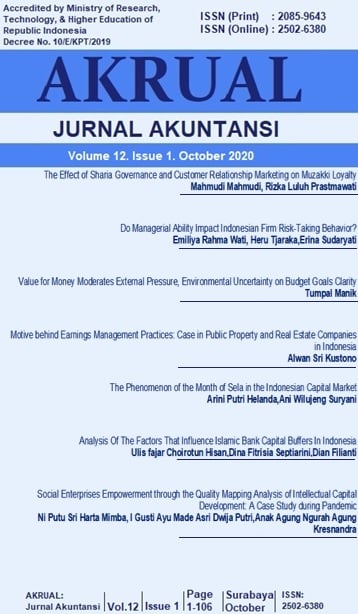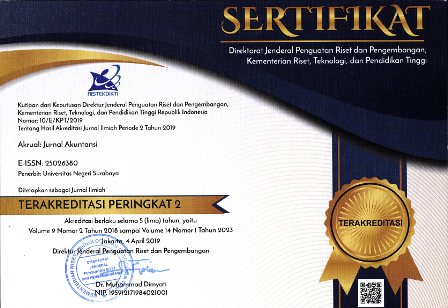Analysis Of The Factors That Influence Islamic Bank Capital Buffers In Indonesia
DOI:
https://doi.org/10.26740/jaj.v12n1.p80-93Keywords:
Cpital buffer, Risk profile, Macroeconomic conditionsAbstract
Banks are trust institutions. An appropriate tool in sustaining trust is the capital adequacy of the bank (capital buffer). This study aims to analyze the effect of financing risk (NPF), operational risk (BOPO), market risk (NI), Third Party Funds (DPK), GDP Growth (GDPG) and inflation on BUS capital buffers in Indonesia during the 2014-2018 period. This study uses panel data regression method with a sample of 12 BUS based on purposive sampling technique. BOPO, DPK, GDPG, and INF were found to have a significant effect on BUFF, where BOPO, DPK, and INF had a negative effect, while GDPG was positive. So operational risk, third party funds, GDP Growth, and inflation can be said to be determinants of BUS capital buffers in Indonesia in the 2014-2018 period. Financing risk (NPF) and market risk (NI) have no significant effect on BUS capital buffer in the study period. Regarding basel III implementation, operational risk is a significant determinant of capital buffer, and capital buffer is found to be procyclical to the Indonesian economy. Future studies can include more risk measurement variables and other macroeconomic variable
References
Agustuty, L., & Ruslan, A. (2019). Determinan Capital Buffer Pada Industri Perbankan Di Indonesia. Movere Journal, 1(2), 164174.
Atici, G., & Gursoy, G. (2013). The determinants of capital buffer in the Turkish banking system. International Business Research Journal, 6(1), 224234. doi:10.5539/ibr.v6n1p224
Awojobi, O. (2011). Analysing risk management in banks: Evidence of bank efficiency and macroeconomic impact. Journal of Money, Investment and Banking, 22.
Bayuseno, V., & Chabahib. (2014). Analysis of factors affecting banking capital buffer in Indonesia (Study of conventional banks going public in the 2014-2013 period). Diponegoro Journal of Management, 3(4), 113.
Bitar, M., Kabir Hassan, M., & Hippler, W. J. (2018). The determinants of Islamic bank capital decisions. Emerging Markets Review, 35, 4868. doi:10.1016/j.ememar.2017.12.002
Carvallo, O., Kasman, A., & Kontbay-Busun, S. (2015). The Latin American bank capital buffers and business cycle: Are they pro-cyclical? Journal of International Financial Markets, Institutions and Money, 36, 148160. doi:10.1016/j.intfin.2015.02.003
Daher, H., Masih, M., & Ibrahim, M. (2015). The unique risk exposures of Islamic banks capital buffers: A dynamic panel data analysis. Journal of International Financial Markets, Institutions and Money, 36, 3652. doi:10.1016/j.intfin.2015.02.012
Ghosh, S. (2017). Capital buffers in Middle East and North Africa (MENA) banks: is market discipline important? International Journal of Islamic and Middle Eastern Finance and Management, 10(2), 208228. doi:10.1108/imefm-08-2016-0101
Huda, N. et al. (2008). Islamic Macro Economy: Theoretical Approach. Kencana Prenada Media Group.
Johnson, F. P., & Johnson, R. D. (1985). Commercial bank management. Dryden Pr.
Jokipii, T., & Milne, A. (2008). The cyclical behaviour of European bank capital buffers. Journal of Banking & Finance, 32(8), 14401451. doi:10.1016/j.jbankfin.2007.12.001
Koch, T. W., & MacDonald, S. S. (2003). Bank management (Fifth Edit). South-Western Thomson.
Mankiw, N. G., Quah, E., & Wilson, P. (2014). Pengantar Ekonomi Makro: Edisi Asia. Jakarta: Salemba Empat.
Mili, M., Sahut, J.M., Trimeche H., & Teulon, F. (2016). Determinants of the capital adequacy ratio of foreign banks subsidiaries: The role of interbank market and regulation. Research in International Business and Financ, 42, 442-453. http://dx.doi.org/doi:10.1016/j.ribaf.2016.02.002
Muhammad. (2005). Sharia bank management. UPP STIM YKPN.
Noreen, U., Alamdar, F., & Tariq, T. (2016). Capital buffers and bank risk: Empirical study of adjustment of Pakistani banks. International Journal of Economics and Financial Issues, 6(4).
OJK. (2015). Surat Edaran Otoritas Jasa Keuangan No. 34/SEOJK.03/2015 tentang Perhitungan Aset Tertimbang Menurut Risiko untuk Risiko Kredit Menggunakan Metode Standar bagi Bank Umum Syariah.
OJK. (2015). Surat Edaran Otoritas Jasa Keuangan No. 35/SEOJK.03/2015 tentang Perhitungan Aset Tertimbang Menurut Risiko untuk Risiko Pasar Menggunakan Metode Standar bagi Bank Umum Syariah.
OJK. (2019). OJK Terapkan Perhitungan Risiko Pasar Basel III Terbaru. SP 02/DHMS/OJK/I/2019.
Prasetyantoko, A., dan Soedarmono, W. (2015). The determinants of capital buffer in Indonesian banking. Social Science Research Network, 370.
RI Law. (2008). Syariah banking. Jakarta: Law of the Republic of Indonesia.
Sutrisno, M. (2018). Factors determinant of bank capital buffer: empirical study on Islamic rural banking in Indonesia. 15th International Symposium on Management (INSYMA 2018).
Umam, K. (2013). Islamic banking management. CV Loyal Library.
Van Greuning, H., & Iqbal, Z. (2007). Risk analysis for Islamic banks. The world bank.
Williams, H. T. (2011). Determinants of capital adequacy in the Banking Sub-Sector of the Nigeria Economy: Efficacy of Camels.(A Model Specification with Co-Integration Analysis). International Journal of Academic Research in Business and Social Sciences, 1(3), 233. doi:10.6007/ijarbss.v1i2.36
Xu, L., Lee, S.-C., & Fu, Y. (2015). Impacts of capital regulation and market discipline on capital ratio selection: evidence from China. International Journal of Managerial Finance. doi:10.1108/ijmf-02-2014-0021
Zhu, C., & Chen, L. (2016). An empirical study on the capital buffer of rural commercial banks in China. Journal of Finance and Economics, 4(3), 97102.
Downloads
Additional Files
Published
How to Cite
Issue
Section
License
Copyright (c) 2020 AKRUAL: Jurnal Akuntansi

This work is licensed under a Creative Commons Attribution-NonCommercial 4.0 International License.
 Abstract views: 660
,
Abstract views: 660
, PDF Downloads: 579
,
PDF Downloads: 579
, PDF Downloads: 0
PDF Downloads: 0


















